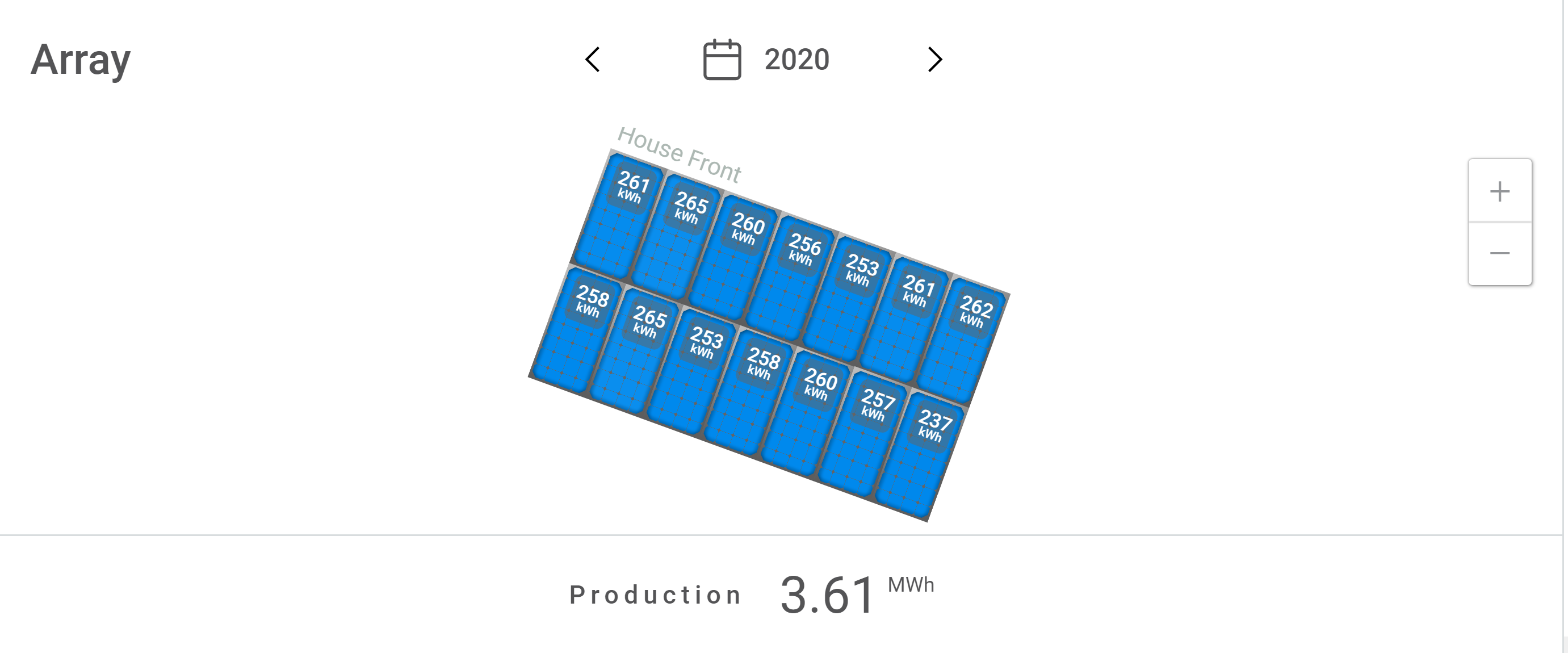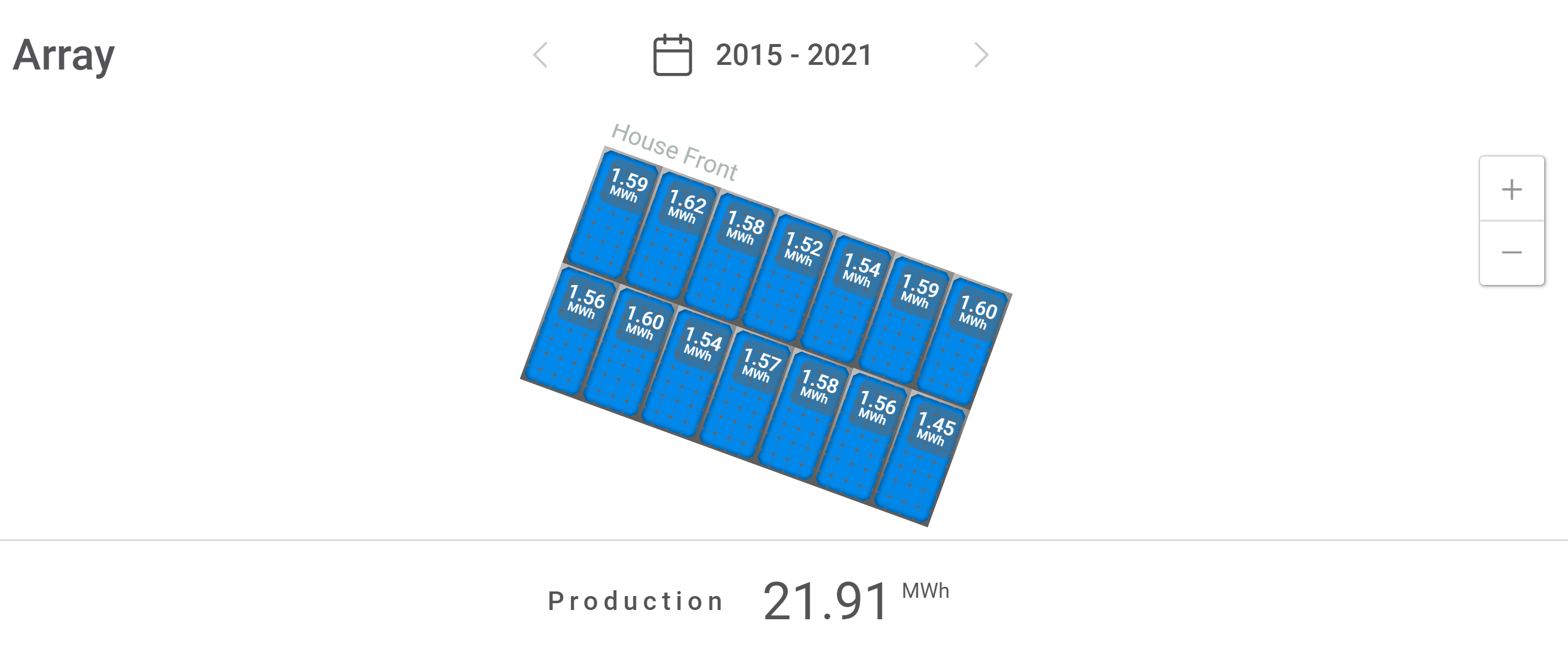We’d like to remind Forumites to please avoid political debate on the Forum.
This is to keep it a safe and useful space for MoneySaving discussions. Threads that are – or become – political in nature may be removed in line with the Forum’s rules. Thank you for your understanding.
📨 Have you signed up to the Forum's new Email Digest yet? Get a selection of trending threads sent straight to your inbox daily, weekly or monthly!
Solar panels - how much electricity are your panels actually generating?
Comments
-
That's not the only question or even the most important question. The most important question is whether you can use the electricity at the time when it is being generated. You'll get very much more in summer than in winter and peak power when your panels are face-on to the sun. You could charge your EV if it is frequently at home during the day. You could charge a home battery assuming you cannot use your EV battery to power your home. You can heat water, particularly if you have a hot water cylinder. Solar panels aren't much help with a heat pump because the time you have solar power is the time you don't need to run your heat pump.The question is to see if they actually generate the electricity that is claimed.Reed1 -
I would say its not quite that as you will still need hot water all year and heating on a sunny winters day ,the problem is trying to intergrade the heat pump and the solar so they work together in a smart way. Using you excess solar to heat the water via an immersion isn't very good with a heat pump easy as the COP of the heat pump may mean you are better exporting the electricity.Reed_Richards said:
Solar panels aren't much help with a heat pump because the time you have solar power is the time you don't need to run your heat pump.The question is to see if they actually generate the electricity that is claimed.8kw system spread over 6 roofs , surrounded by trees and in a valley.1 -
Wp is Watts peak. It is the theoretical maximum output of a panel/array. Actually, many panels over-perform, when new, but all panels gradually lose efficiency over time. This rate of decline will be noted in the specifications.
3 -
Coffeekup said:Question... What is per WP?Verdegris has answered this, but here's some context.When you buy a solar power installation, there will be a headline system power - say "4kW". This will (or should) be the sum total of the individual name-plate ratings of the solar panels installed. Her's an example of a manufacturer's plate (well, sitcker):
 This particular panel is rated at 240Wp. If you had 16 of them installed as part of a system, the system power would be 3840Wp - not quite 4kW but pretty close.Those panels will be connected to an inverter. The inverter rating will almost always be lower than the system power, typically 80% to 90% of it for a domestic system*. There are good reasons for this regarding the relationship between panel and inverter performance, plus inverters are made in a relatively small range of ratings. My imaginary 3840Wp system might have a 3200-3680W** inverter.* This could be much less for a commercial solar farm; panels are cheap but grid connections are expensive, so you might find a system where the inverters are only rated for 60% of the total panel power.** 3680W is one of those numbers that makes sense in context; it's 230V x 16A, and is the li9mit below which you don;'t need special permission from your electricity network operator for a small PV system.N. Hampshire, he/him. Octopus Intelligent Go elec & Tracker gas / Vodafone BB / iD mobile. Ripple Kirk Hill Coop member.Ofgem cap table, Ofgem cap explainer. Economy 7 cap explainer. Gas vs E7 vs peak elec heating costs, Best kettle!
This particular panel is rated at 240Wp. If you had 16 of them installed as part of a system, the system power would be 3840Wp - not quite 4kW but pretty close.Those panels will be connected to an inverter. The inverter rating will almost always be lower than the system power, typically 80% to 90% of it for a domestic system*. There are good reasons for this regarding the relationship between panel and inverter performance, plus inverters are made in a relatively small range of ratings. My imaginary 3840Wp system might have a 3200-3680W** inverter.* This could be much less for a commercial solar farm; panels are cheap but grid connections are expensive, so you might find a system where the inverters are only rated for 60% of the total panel power.** 3680W is one of those numbers that makes sense in context; it's 230V x 16A, and is the li9mit below which you don;'t need special permission from your electricity network operator for a small PV system.N. Hampshire, he/him. Octopus Intelligent Go elec & Tracker gas / Vodafone BB / iD mobile. Ripple Kirk Hill Coop member.Ofgem cap table, Ofgem cap explainer. Economy 7 cap explainer. Gas vs E7 vs peak elec heating costs, Best kettle!
2.72kWp PV facing SSW installed Jan 2012. 11 x 247w panels, 3.6kw inverter. 34 MWh generated, long-term average 2.6 Os.4 -
That is such a good question and shows how 'we' automatically switch to PV brain mode.Coffeekup said:Question... What is per WP?
PV panels have a power rating, for instance 370Wp. This means that they can generate a peak output of 370W in ideal sustained conditions/temperatures. Because the power fluctuates so much, based on temp, sunshine, shading etc etc they get the label p for peak.
So a ten panel system of 370Wp panels would be a 3.7kWp system, but for simplicity just ignore the p.
In the UK a decent south facing system that's not too far north, would probably generate around 1,000kWh pa for each 1kW(p) of installed panels, which is also 1kWh/1W(p) of installed PV.
Sorry for all the numbers and bumpf, it's actually an easy subject to chat about ..... so long as 'we' don't jump straight in with a whole host of acronyms and abrreviations. Mart. Cardiff. 8.72 kWp PV systems (2.12 SSW 4.6 ESE & 2.0 WNW). 28kWh battery storage. Two A2A units for cleaner heating. Two BEV's for cleaner driving.
Mart. Cardiff. 8.72 kWp PV systems (2.12 SSW 4.6 ESE & 2.0 WNW). 28kWh battery storage. Two A2A units for cleaner heating. Two BEV's for cleaner driving.
For general PV advice please see the PV FAQ thread on the Green & Ethical Board.3 -
Trouble is, the heat pump typically demands up to 6 kW for about 15 minutes to bring the water temperature back up to 50 C when it drops below 40 C. That's more than my battery and the panels together can supply almost all of the time so I would have to import some electricity to have spare to export later. If I just use the immersion heater I can take the cylinder temperature up to 75 C and never have to run the heat pump at all. Since I am not actually metered on the electricity I export and anyway most of us get paid a pittance for exported electricity compared to the current import cost, then I think my way is best and I am not better exporting the electricity.arty688 said:
...Using you excess solar to heat the water via an immersion isn't very good with a heat pump easy as the COP of the heat pump may mean you are better exporting the electricity.Reed3 -
This is our array installed in 2015, it's a 3.5KWp system (14x250W panel with enphase micro inverter)
Generation in 2020
Lifetime Generation
The maximum I have seen the system export to the grid was 3.3KW(usually in March/April when its bright, sunny and bitterly cold).
We also had iBoost installed at the same time, best £200 spent, it will start heating if the export is more than 100W“Don't raise your voice, improve your argument." - Desmond Tutu
System 1 - 14 x 250W SunModule SW + Enphase ME215 microinverters (July 2015)
System 2 - 9.2 KWp + Enphase IQ7+ and IQ8AC (Feb 22 & Sep 24) + Givenergy AC Coupled inverter + 2 * 8.2KWh Battery (May 2022) + Mitsubishi 7.1 KW and 2* Daikin 2.5 KW A2A Heat Pump2 -
Thanks everyone for the comments. I'm finding this thread very useful.
Quick question though - on the thread 'Talking 'bout My Generation' (great name), people report generating in Os. Could someone tell me what this is please?
5.2kW (13 x Hyundai 400w), SSE, Central Bedfordshire. Panels installed Dec 2021. Hyundia e-Kona.0 -
It's already been mentioned.QrizB said:There are a few of us here, participating in that thread, who have had them for around ten years, and have average daily outputs of 2.5 - 3.0 O's (that's 2.5 - 3.0 watt-hours per watt of panel). Obviously the number is much bigger in the summer and much smaller in winter.Reed1 -
Reed_Richards said:
It's already been mentioned.QrizB said:There are a few of us here, participating in that thread, who have had them for around ten years, and have average daily outputs of 2.5 - 3.0 O's (that's 2.5 - 3.0 watt-hours per watt of panel). Obviously the number is much bigger in the summer and much smaller in winter.Thanks R_R! The idea is to let you directly compare the performance of different-sized systems.To illustrate, if you have a 1kWp system and generate 1kWh in a day, that's one O. If you generate 2kWh in a day with the same system, that's 2 O's.For a 3kWp system, 3kWh in a day is one O, and 6kWh in one day would be two O's.N. Hampshire, he/him. Octopus Intelligent Go elec & Tracker gas / Vodafone BB / iD mobile. Ripple Kirk Hill Coop member.Ofgem cap table, Ofgem cap explainer. Economy 7 cap explainer. Gas vs E7 vs peak elec heating costs, Best kettle!
2.72kWp PV facing SSW installed Jan 2012. 11 x 247w panels, 3.6kw inverter. 34 MWh generated, long-term average 2.6 Os.1
Confirm your email address to Create Threads and Reply

Categories
- All Categories
- 352.7K Banking & Borrowing
- 253.8K Reduce Debt & Boost Income
- 454.6K Spending & Discounts
- 245.8K Work, Benefits & Business
- 601.9K Mortgages, Homes & Bills
- 177.7K Life & Family
- 259.7K Travel & Transport
- 1.5M Hobbies & Leisure
- 16K Discuss & Feedback
- 37.7K Read-Only Boards







